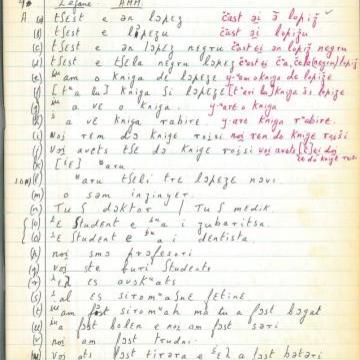Istro-Romanian Linguistic Community in Croatia
The project aimed to help us expand our reach on the Istro-Romanian (IR) linguistic community in Croatia by piloting a collaboration with the Lapidarium Museum in Novigrad, which focuses on the cultural heritage of the region. It was intended as a creative response to the observed technological reluctance of the remaining speakers of the language towards our online community-sourcing site (Zooniverse, www.istrox.uk), notwithstanding their overall enthusiasm for our research project. KEI funding was also aimed at helping us avoid potentially damaging loss of momentum between an earlier, John Fell-funded stage of ISTROX and future long-term research projects developed under the ISTROX umbrella.
We also wanted to introduce the Lapidarium museum into our ongoing conversation with the Istro-Romanian community and to cement our partnership, to prepare the ground for our co-curated exhibition – titled 50 Years of the Istro-Romanian Language: from the Oxford-Hurren collection to the ISTROX project - which was open in Novigrad from 26 June 2022 to 24 August 2022.
For five months, during the first half of 2022, we shared with the Lapidarium museum, through our social media channels (ISTROX; Musej-Museo Lapidarium), a series of bilingual posts which included selected heritage audio and photo material and a range of accessible linguistic and historical questions addressed to the IR community. Through these posts we aimed to identify new IR-speakers and map their geographical distribution and, wherever possible, persuade our respondents to become involved in our online community-sourcing of linguistic information.
The members of the IR community enjoyed these posts and viewed and shared our audio clips: see, for instance Žejane, 1967. Vesna Sanković ('Kljomina'), 8 years old, recorded by the linguist Tony Hurren (https://tinyurl.com/mr29pmej); Šušnjevica, 1966. Gracijela Bortul, 14 years old, recorded by the linguist Tony Hurren (https://tinyurl.com/yck4pxhc). However, their engagement rarely extended beyond specific social media reactions; only a few speakers replied to our questions, whether directly in the “comments” section of our page or by email as we suggested. This is perhaps unsurprising given the very small size of the community.
The most successful aspect of the project was the special preview that we organized for the IR community on the opening day of the exhibition. We announced the preview several weeks before the opening and invited those interested to use the transport that we organized between the IR villages and the museum. This was part of our attempt to reach in particular the more senior members of the community, perhaps less proficient online, for whom this offline opportunity to meet us and encounter the Hurren material was likely to feel more natural than through our website or Zooniverse site. Around sixty members of the community, of all ages, attended the opening, forty-eight of them using the transport that we provided from the villages (see the photos below). The visitors were enthusiastic about our project and exhibition. For us, the preview was an exceptional opportunity to meet them and thus to extend our reach into the community beyond the small circle of former collaborators of Hurren, their relatives, and the diasporic members of the community with whom we have been in touch in the previous years. We added approximately fifty new contacts to our database – people with whom we established direct contact, most of them still speaking or understanding the language.
According to the estimates of Dr. Jerica Ziherl, the director of Lapidarium, the exhibition attracted about 900 visitors. Apart from helping with our reach deeper into the IR community in Croatia, the exhibition contributed to the visibility of this community in the Croatian media and among the Croatian population (see the links to Croatian press below). It did this by telling the previously unknown story of a long-term, transnational research relationship between a British researcher (Antony Hurren, helped by his spouse, Vera) and a small linguistic community in Croatia, which appealed to the general public and reached beyond the IR community. Our social media posts also boosted the online audience for the previously unknown Hurren heritage material which remains available online.
As part of our collaboration, The Lapidarium museum developed an exhibition which highlighted the linguistic and cultural heritage of the Istrian peninsula. The staff of the museum travelled to the IR villages during the preparatory phase of the exhibition and became interested in the history and the present life of the IR community. Dr. Jerica Ziherl, the director of Lapidarium, has expressed her interest in continuing to develop future exhibitions focusing more closely on each of the two villages traditionally inhabited by IR speakers. She will be visiting Oxford in November to return the objects lent to us by Mrs Hurren and to discuss plans for the future.
Subject to further funding, we intend to continue ISTROX in the coming years. In a post-pandemic context, it is likely that we will reorient more strongly towards face to face interviews, yet our Zooniverse site will remain open as a ‘long tail’ form of data collection.
Materials produced as part of the project:
- Interview with Vera Hurren, the wife of linguist Tony Hurren, on his work with the IR community in in the Istrian peninsula – published on the ISTROX website (https://tinyurl.com/y6jv9sbb)
- Edited version of the interview published as a brochure which was available in the exhibition, together with a flyer which provided information about the ways in which the IR speakers could contribute to IISTROX
- The ISTROX exhibition in the Croatian press (selection):
https://tinyurl.com/25xdrea9
https://tinyurl.com/mrxf2nyp
https://tinyurl.com/2wm47z9x
https://tinyurl.com/mxfw4vhk
https://tinyurl.com/4u9u9ukz
https://tinyurl.com/2wm47z9x
[Radio Pula – June 2022]
https://tinyurl.com/3um95225
[TV - Novigradska kronika, August 2022; 10’50” – 22’50”; Croatian language only)
Back to: Istro-Romanians: Linguistic Heritage in Online Conversations



